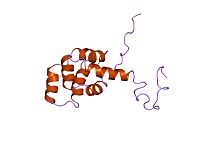
Photo from wikipedia
In the 20th century, researchers studying animal and plant signaling pathways discovered a protein domain that is shared across diverse innate immune systems: the Toll/interleukin-1/resistance gene (TIR) domain. The TIR… Click to show full abstract
In the 20th century, researchers studying animal and plant signaling pathways discovered a protein domain that is shared across diverse innate immune systems: the Toll/interleukin-1/resistance gene (TIR) domain. The TIR domain is found in several protein architectures and was defined as an adaptor that mediates protein-protein interactions in animal innate immunity and developmental signaling pathways. However, studies of nerve degeneration in animals—and subsequent breakthroughs in plant, bacterial, and archaeal systems—revealed that TIR domains possess enzymatic activities. We provide a synthesis of TIR functions and the role of various related TIR enzymatic products in evolutionarily diverse immune systems. These studies may ultimately guide interventions that would span the tree of life, from treating human neurodegenerative disorders and bacterial infections to preventing plant diseases. Description A common core of immune responses Dealing with pathogens is a constant struggle for many life-forms, and innate and adaptive immune systems are needed to support survival. Essuman et al. reviewed the latest insights into the Toll/interleukin-1 resistance/receptor (TIR) domain proteins, which support immune responses across the tree of life, from archaea to bacteria to plants to humans. TIR domains function in innate immune signaling pathways, as well as in axon degeneration in animals. Some, but not all, TIR domains have enzymatic activity. TIR nicotinamide adenine dinucleotide hydrolase activity starves phages as they infect prokaryotes and promotes hypersensitive cell death in a plant’s response to pathogens. Plant TIR domains can also synthesize small, nucleotide-based second messengers that initiate an immune response. —PJH A review explains that shared enzymatic functions in innate immunity build diverse immune systems from archaea to bacteria to plants to humans. BACKGROUND Diverse organisms, from archaea and bacteria to plants and humans, use receptor systems to recognize both pathogens and dangerous self-derived or environmentally derived stimuli. These intricate, well-coordinated immune systems, composed of innate and adaptive components, ensure host survival. In the late 20th century, researchers identified the Toll/interleukin-1/resistance gene (TIR) domain as an evolutionarily conserved component of animal and plant innate immune systems. Today, TIR-domain proteins are known to be broadly distributed across the tree of life. The TIR domain was first recognized as an adaptor for the assembly of macromolecular signaling complexes in mammalian innate immune pathways. Work on axon degeneration in animals—as well as on plant, archaeal, and bacterial immune systems—has uncovered additional enzymatic activities for TIR domains. ADVANCES Mammalian axons initiate a self-destruct program upon injury and during disease that is mediated by the sterile alpha and TIR motif containing 1 (SARM1) protein. The SARM1 TIR domain enzymatically consumes the essential metabolic cofactor nicotinamide adenine dinucleotide (NAD+) to promote axonal death. Identification of the SARM1 NAD+-consuming enzyme (NADase) revealed that TIR domains can function as enzymes. Given the evolutionary conservation of TIR domains, studies investigated whether the SARM1 TIR NADase was also conserved. Indeed, bacteria, archaea, and plant TIR domains possess NADase activity. In prokaryotes, TIR NADase activity is found in an ancient antiphage immune system. In plants, identification of TIR NADase activity and linkage of TIR enzymatic products to downstream signaling components addressed the question of how nucleotide-binding, leucine-rich repeat (NLR) receptors trigger hypersensitive cell death during an immune response. Studies in plants show that their TIR domains can cleave nucleic acids and possess 2′,3′ cyclic adenosine monophosphate (2′,3′-cAMP) and 2′,3′ cyclic guanosine monophosphate (2′,3′-cGMP) synthetase activity that aids cell death programs in plant innate immunity. Thus, TIR domains constitute an ancient family of enzymes that are activated in immune and cell death pathways. OUTLOOK The discovery of TIR-domain enzyme activities carries implications for innate immunity and neurodegeneration. The identification of the SARM1 NADase defined a drug target for a wide number of neurodegenerative diseases that is being exploited in both preclinical and clinical studies. Hyperactive mutations in the SARM1 NADase have been discovered in amyotrophic lateral sclerosis (ALS) patients. Future work will seek to clarify the contribution of the SARM1 axon degeneration pathway to ALS pathogenesis. NAD+ biology influences cellular processes from metabolism to DNA repair to aging. How TIR enzymes influence the NAD+ metabolome and its associated pathways in bacteria, archaea, plants, and animals will be an exciting area for upcoming investigation. The discovery of the diversity of TIR enzymatic products is revealing signaling pathways across kingdoms. Discovery of TIR enzymatic function in plants and animals may yet inspire studies of enzymatic functions for Toll-like receptors in animals. We anticipate that cross-kingdom studies of TIR-domain function will guide interventions that will span the tree of life, from treating human neurodegenerative disorders and bacterial infections to preventing plant diseases. Conserved TIR-domain enzymatic activity. TIR-domain proteins from prokaryotes and eukaryotes cleave NAD+ into nicotinamide (Nam), ADP-ribose (ADPR), cyclic ADP-ribose (cADPR), isomers of cyclic ADP-ribose (2′ or 3′cADPR), and related molecules [e.g., phosphoribosyl adenosine monophosphate (pRib-AMP)]. Plant TIR domains also possess a nuclease activity, can degrade DNA and RNA, and can function as a 2′,3′-cAMP or 2′,3′-cGMP synthetase. TIR enzymatic activity drives cell death and immune pathways across kingdoms. TIR activity can kill cells directly through NAD+ depletion or indirectly using enzymatic products as signal molecules. The representative TIR domain structure shown here is Protein Data Bank ID 6O0Q. EDS1, enhanced disease susceptibility 1; ThsA, Thoeris A.
Journal Title: Science
Year Published: 2022
Link to full text (if available)
Share on Social Media: Sign Up to like & get
recommendations!